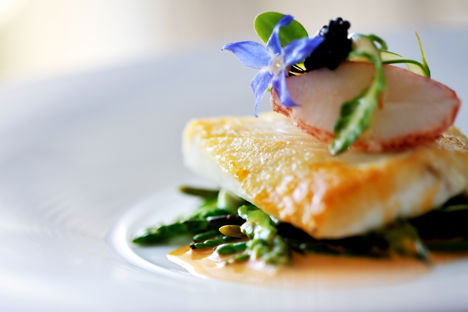Brill is an underrated flatfish related to the highly-prized turbot, with similarly sweet and firm flesh (but it thankfully tends to be on the cheaper side). The fish has smooth brown, flecked skin with a white underside. They can reach a whopping 75cm in diameter, but average 35cm. Like the turbot, one medium-sized fish provides 4 nice large fillets.
What to look for when buying brill
Brill comes into season in British waters in May and is caught until December, but is at its best between June and August. As with all fresh fish, check for a clean smell of the sea, bright red gills and clear eyes as a sign of quality. You can buy brill whole, in fillets or as tranche steaks.
Make sure you check the sustainability-rating of the fish before buying (this will depend on the fishery it was caught in). If unavailable, you can replace brill in most recipes with another firm flatfish such as Dover sole, turbot or halibut.
How to cook brill
Due to the thin fillets, smaller fish (less than 1kg) are best cooked on the bone – either whole or tranche cut. This helps the fish stay juicy, plus the bones add flavour. Remove the head and fins and make sure the fish has been gutted. Bake in a hot oven – it’s ready when the skin comes away from the flesh easily and the flesh comes away from the bones when pressed.
If you fancy brushing up on your knife skills, have a go at filleting the brill yourself. As well as improving your skills, you can make a delicious fish stock with the bones, which you can then poach the fish in or make a sauce.
The fish’s firm texture makes it an excellent candidate to pan-fry with a good basting of butter, or if you’re looking for something healthier, try a simple steamed fillet.
What brill goes with
Brill is a very versatile fish. Its firm flesh can stand up to stronger flavours such as a punchy lemon and caper dressing, or a rich lobster sauce like in Simon Hulstone’s beautiful fillet of brill recipe. As it’s in season across half the year, it can be paired with both sweet, summer flavours like this brill, English pea and heirloom tomato dish and earthy autumnal flavours like Shay Cooper’s crusted brill recipe with sautéed ceps and Jerusalem artichoke purée.
The firm texture also makes this flat fish ideal for curing, and it holds together very well when slicing. Although you normally see oilier fish such as salmon or trout being cured, the sweetness of the brill flesh lends itself beautifully to more delicate cure flavourings such as citrus or elderflower.
Get in touch
Please sign in or register to send a comment to Great British Chefs.

